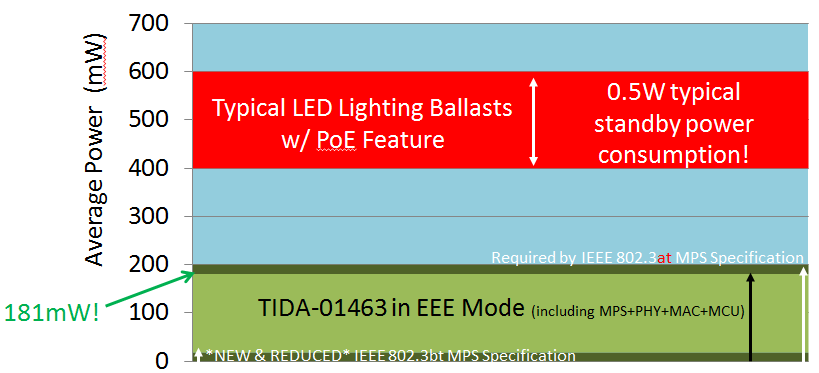-
Less (Standby) Power and More Light
Less (Standby) Power and More Light
Thomas Lewis
With the highly anticipated ratification of the latest Power over Ethernet (PoE) standard, Institute for Electrical and Electronics Engineers (IEEE) 802.3bt, an increasing number of applications are considering PoE as their power delivery technology of choice. Historically, on the load (also referenced to as the Powered Device or PD) side of the cable, PoE has been very popular with Internet protocol (IP) surveillance cameras, wireless access points, IP phones, and small home and office routers. A new application, PoE connected lighting, is garnering a lot of attention and consideration.
PoE is not currently an option in today’s light-emitting diode (LED) lighting ballasts for two reasons.
First, given the absolute power limit of the current IEEE 802.3at standard, PoE could only deliver 25.5W at the end of 100m of standard Ethernet cable, thus limiting the lumens generated from a PoE-based system and prohibiting its use for smart building use cases. The upcoming IEEE 802.3bt standard – expected to publish in late summer 2018 – eliminates this issue. With the new standard, power delivered to the PD can achieve 71W, which will meet the demands for many of the most popular LED ballast models available today.
Second, standby power is a critical consideration for connected lighting. Unlike a traditional light luminaire with a hardware switch, intelligent LED ballasts are usually powered even when the light is off. Having the sensors and other intelligence remain on while the luminaire is off enables fast turn-on.
Reducing overall power consumption is a major selling point for intelligent LED ballasts, making it critical to keep standby power as low as possible. Today, the minimum maintain power signature (MPS) overhead budget is ~115mW (calculated as 50V x 10mA x 75ms/75ms + 250ms) at a VIN of 50V. Most designs will need to add margin to the MPS current and duty cycle to compensate for integrated circuit tolerance and noise. Thus, a typical design following the IEEE 802.3at standard will likely consume 150mW-200mW of power. This may not seem a big deal, but larger installations have hundreds or even thousands of lighting fixtures. It adds up fast!
The new IEEE 802.3bt standard can achieve significant improvements in standby power consumption. Using the Connected LED Lighting IEEE802.3bt Power Over Ethernet (PoE) Reference Design, the entire standby power consumption is just 181mW (see Figure 1). This includes all of the operation required during standby (powered device, microcontrollers [MCU], physical layer [PHY], media access control [MAC], etc.). It’s easy to see why lighting manufacturers are excited about the new MPS specification in the upcoming IEEE 802.3bt standard. When combined with an optimized design, the MPS specification significantly helps minimize standby consumption and reduce the carbon footprint.
 Figure 1 Input Power Consumption in
Standby (Lights off)
Figure 1 Input Power Consumption in
Standby (Lights off)Of course, some may question the value of PoE-connected lighting beyond these straightforward power demand and overall system-efficiency calculations. What about cost? According to one lighting solution provider, installation costs can be reduced by as much 25% and commissioning costs by as much as 50% when installing PoE-based networks.
As for end-user value, connected lighting brings many exciting new features, including customized brightness and color control; activity tracking/people counting; and visible light communication (VLC), which ultimately enables indoor positioning systems.
Early feedback on adding PoE to connected LED lighting ballasts is positive and gaining momentum. TI’s TPS2372-3 and TPS2372-4 PoE powered devices were developed specifically for such applications.
Additional Resources
- Read the EA blog post "Would you like a logo to go with your PoE system?"
- For more on the upcoming IEEE802.3bt standard, check out the TPS2373 and TPS2372 and read the blog post, “IEEE802.3bt: A Guide to Understanding the Current Spec.”
IMPORTANT NOTICE AND DISCLAIMER
TI PROVIDES TECHNICAL AND RELIABILITY DATA (INCLUDING DATASHEETS), DESIGN RESOURCES (INCLUDING REFERENCE DESIGNS), APPLICATION OR OTHER DESIGN ADVICE, WEB TOOLS, SAFETY INFORMATION, AND OTHER RESOURCES “AS IS” AND WITH ALL FAULTS, AND DISCLAIMS ALL WARRANTIES, EXPRESS AND IMPLIED, INCLUDING WITHOUT LIMITATION ANY IMPLIED WARRANTIES OF MERCHANTABILITY, FITNESS FOR A PARTICULAR PURPOSE OR NON-INFRINGEMENT OF THIRD PARTY INTELLECTUAL PROPERTY RIGHTS.
These resources are intended for skilled developers designing with TI products. You are solely responsible for (1) selecting the appropriate TI products for your application, (2) designing, validating and testing your application, and (3) ensuring your application meets applicable standards, and any other safety, security, or other requirements. These resources are subject to change without notice. TI grants you permission to use these resources only for development of an application that uses the TI products described in the resource. Other reproduction and display of these resources is prohibited. No license is granted to any other TI intellectual property right or to any third party intellectual property right. TI disclaims responsibility for, and you will fully indemnify TI and its representatives against, any claims, damages, costs, losses, and liabilities arising out of your use of these resources.
TI’s products are provided subject to TI’s Terms of Sale (www.ti.com/legal/termsofsale.html) or other applicable terms available either on ti.com or provided in conjunction with such TI products. TI’s provision of these resources does not expand or otherwise alter TI’s applicable warranties or warranty disclaimers for TI products.
Mailing Address: Texas Instruments, Post Office Box 655303, Dallas, Texas 75265
Copyright © 2023, Texas Instruments Incorporated